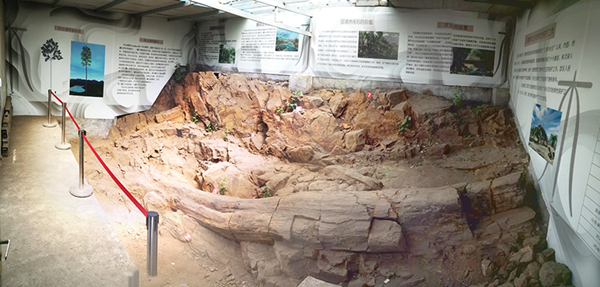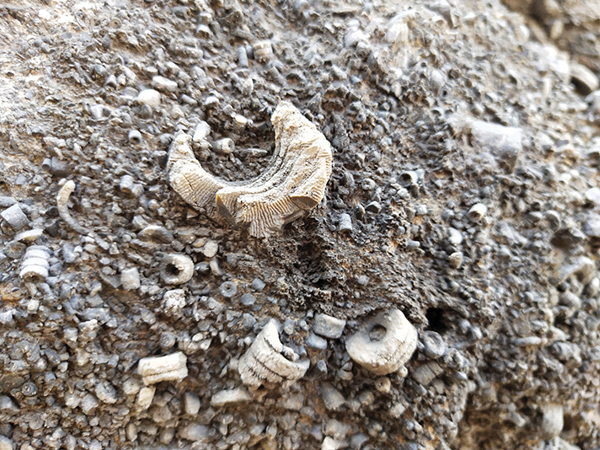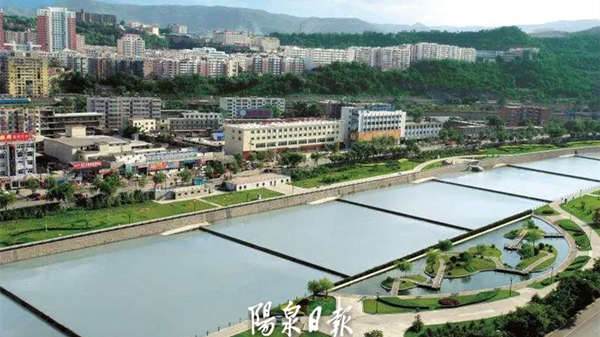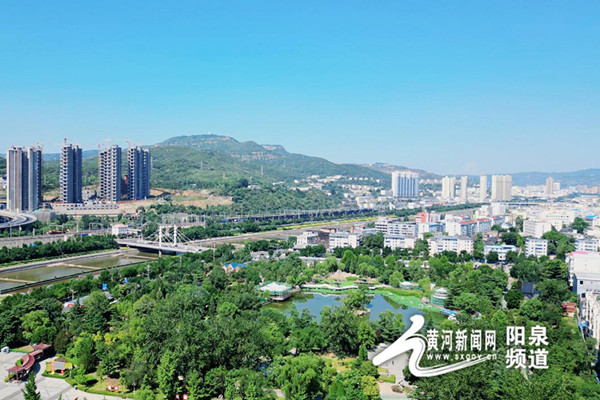Geological heritage tour in Yangquan
In the suburbs of Yangquan, there are many valuable geological relics from hundreds of millions of years ago.
Wood Fossil Pit of Sanquan village

The 40-square-meter No 1 protection pit of Yangquan Permian wood fossils in Sanquan village, Yangquan [Photo/Yangquan Evening News]
This geological relic site was discovered in 2019 in Sanquan village, Yinying town, Yangquan.
A group of wood fossils distributes in a 40-square-meter No 1 protection pit of Yangquan Permian wood fossils in the geological relic site.
The thickest part of the No 1 large-scale wood fossil, which is about 295 million years old, has a cross-sectional diameter of about 1.36 meters and is 8 meters long, and its roots are relatively intact.
In 2020, experts from the Chinese Academy of Sciences and the United States proved that the wood fossil is the thickest cordaite fossil from the late Carboniferous to Permian period ever discovered in China.
According to Bai Zhijun, a technician responsible for the conservation, development and utilization of paleontological fossils at the Yangquan bureau of planning and natural resources, cordaite is an important plant from which coal is produced and mainly grew in dense forests from the Carboniferous to Permian periods.
The No 1 cordaite wood fossil was estimated by experts to be 43.5 meters high during that period, Bai added.
There are another pieces of six fossil wood of various sizes around the No 1 wood fossil, all without annual rings, which means that the climate in the area was warm and humid during the Permian period and that there was no change in seasons, Bai added.
These wood fossils provide important physical evidence for people to study the ancient environment and the evolution of paleontology.
Bus route: take No 301 bus at China Everbright Bank Station, get off at Sanquan Station, and walk for 20 minutes.
Driving route: drive along Xincheng Avenue to Sanquan village and cross the road in the village to National Highway 307 before arriving at the destination.

Stones densely packed with ring-shaped fossils of different sizes are discovered in Pingshang village, Yangquan [Photo/Yangquan Evening News]
Ancient Ocean World of Pingshang village
This geological relic site was discovered in 2012 and is located southwest of Pingshang village and southeast of Liubei Mountain.
The fossils of ancient marine organisms of various shapes and sizes were found in an open land with stones densely packed with ring-shaped fossils of different sizes on surfaces and some shell fossils stacked together.
The fossil group originated from ancient marine life in the early Permian period, about 295 million years ago, according to Bai.
"The fossils are remains mainly of an ancient marine animal called a crinoid. There are also a large number of cephalopods, gastropods, valvulanids, corals, bryozoans, trilobites and shark teeth fossils," Bai said.
The fossils record the history of ancient marine life hundreds of millions of years ago, witness the changes in the earth's geography and climate from ancient times to the present, and help human beings understand the evolution of ancient organisms.
Bus route: take No 5 bus at Binhe Bus Terminal, get off at Yinying Minecar Guanke Station, and walk for 5 min.
Driving route: drive along Quanzhong Road, Liyin Road, and Yinying West Street to the Yinying Minecar Guanke and walk for 5 min.





